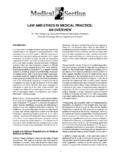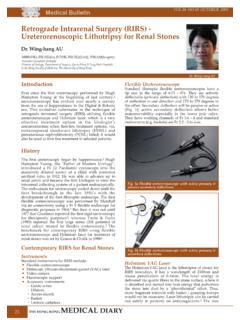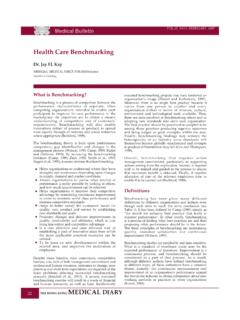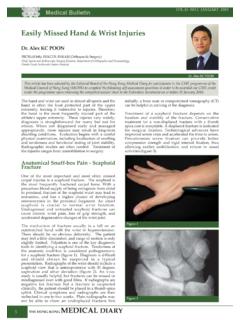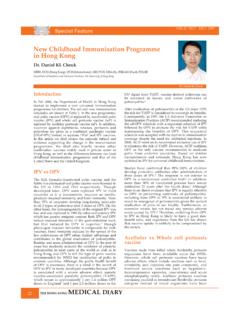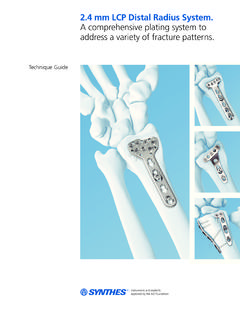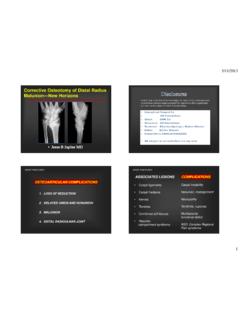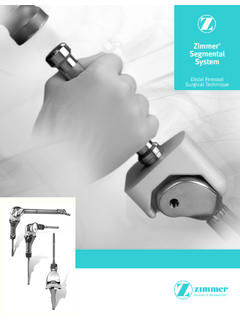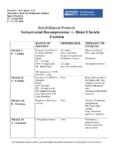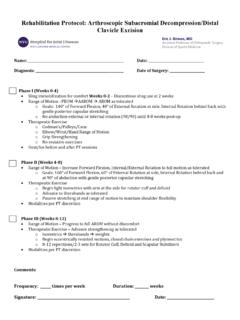Transcription of Distal Clavicle Fractures and Acute Acromioclavicular ...
1 MAY 2006 MedicalBulletin JANUARY 2010 IntroductionClavicle Fractures constitute 44% of all shoulder girdle injuries. Most of them are mid- Clavicle Fractures that unite satisfactorily with non-operative treatment. In contrary, Fractures of the Distal one third of the Clavicle is an exception that carry a high non-union rate. Therefore it is important to recognise this distinct Clavicle fracture as different from those commonly encountered mid- Clavicle Fractures . Distal Clavicle Fractures account for 15% of all Clavicle Fractures . Neer classified this fracture into two types based on the status of the coracoclavicular (CC) ligament. How to Evaluate this Injury Clinically and Radiologically?
2 Most of the Distal Clavicle Fractures are due to a direct blow or fall on the shoulder. Ecchymosis, abrasion wounds and associated swellings are commonly seen. If there is significant fracture displacement, the skin may be subjected to too much tension by the bone spike of the proximal fragment that needs urgent attention. In case of high energy trauma such as road traffic accidents, a detailed examination is needed to exclude other associated injuries. Head and neck injuries are found in up to 10% of cases while ipsilateral rib Fractures as well as associated chest injuries are not shoulder trauma series including AP view, scapular Y view and axillary view of the injured shoulder should be the standard radiographs taken.
3 Classification of the fracture could be made based on the fracture displacement. An axillary view is useful in evaluating the AP translation of the fracture . Computer tomography is sometimes needed in cases of complex and comminuted fracture patterns. Ultrasound and MRI are seldom necessary except associated soft tissue injuries such as a rotator cuff tear is suspected. What will Happen if we Leave the Distal Clavicle Fractures Untreated?Natural history tells us that a Type I fracture of the Distal Clavicle without disruption of the CC ligament is inherently stable and usually will heal with a favourable outcome after conservative treatment.
4 Only a very small percentage of patients will have residual shoulder to the unstable nature of Type II Fractures , the risk of fracture non-union is high with an average of 30%. But are these fracture non-unions all symptomatic that necessitate surgical intervention? Nordqvist in his largest series of Distal Clavicle Fractures found that there were 10 nonunions out of an overall 23 type II Fractures , only two cases were symptomatic. When we review Neer's report, only one non-union case ultimately required surgery. Other literatures also pointed out that patients could still have satisfactory shoulder functions even when the Fractures are not united radiologically.
5 Neer suggested that Type III Fractures are subjected to a higher chance of ACJ arthrosis with late painful symptoms. However Nordqvist did not note any long term problems in his 15 (11-21) years' follow-up is the Current Management Strategy?The type I fracture is a stable injury with an intact CC ligament that prevents the fragments from significant displacement. In Type II Fractures , the Distal Clavicle fragment is subjected to the Distal pull by the weight of the arm and medial pull by the strong pectorii muscles as well as the Latissmus dorsi muscle while the proximal fragment is dragged posteriorly by the trapezius. These disturbing forces contribute to the fracture displacement and the unstable nature of Type II Fractures .
6 The type II fracture is further sub-categorised into Type IIA in which the fracture occurs medial to the CC ligament and Type IIB in which the fracture occurs more laterally with the CC ligament disrupted from the proximal fragment. With identification of more subtypes, the Neer classification of Distal Clavicle Fractures was later modified to include up to five I - Minimally displaced Fractures that occur lateral to the CC ligamentType II - Displaced Fractures that the proximal fragment is detached from the CC ligament Distal Clavicle Fractures and Acute Acromioclavicular Joint InjuriesDr. Wilkie Wai-kee NGAI Dr. Wilkie Wai-kee NGAI MBBS(HK), MScSEM(Bath), MRCS(Edin), FRCSEd(Orth), FHKAM(Orthopaedic Surgery), FHKCOSType III - fracture extension into Acromioclavicular joint (ACJ)Type IV - fracture with periosteal disruption occurring in childrenType V - Avulsion fracture of the Distal Clavicle with the inferior cortical fragment remains attached to the CC ligamentResident Consultant in Orthopedics and Traumatology, Hong Kong Baptist HospitalMedicalBulletin JANUARY 2010 There is no doubt that the initial treatment for Type I and Type III Fractures will be non-operative.
7 An arm sling is offered to support the weight of the arm. A figure of eight splint is not necessary. Pendulum exercises could be started as pain is tolerated. The arm sling could be taken off when the pain has subsided with active assisted and passive mobilisation exercises to start shortly thereafter. Strengthening exercises can be commenced when a pain-free full shoulder range-of-motion achieved. Despite the excellent prognosis of Type I and III Fractures , patients should be informed about the remote chance of late residual shoulder symptoms; especially in type III Fractures , patients will have a higher chance in the development of ACJ arthrosis.
8 For those patients who have significant residual symptoms, operative treatment with Distal Clavicle resection may be needed to alleviate the symptoms. Management of Type II Fractures is always the focus of debate. With a high risk of non-union, some clinicians will suggest operative treatment for all type II Fractures while proponents for non-operative treatment will argue that a lot of these non-unions are asymptomatic. For patients who have marked fracture displacements, potential overlying skin compromise and open injuries, they are clearly indicated for surgery. Others may have the right to opt for non-operative treatment. When non-operative treatment is selected, patients must be carefully counselled and informed of the followings:Rehabilitation after OperationThe arm is placed in a sling for 3 weeks after operation in order to avoid early failure.
9 Rigid fixation using plate and screws allows earlier active mobilisation without shoulder mobilisation exercises should be started as the pain is tolerated. We will not wait for radiological bone union as it may take up to 12 weeks and passive and active assisted shoulder mobilisation exercises should be commenced once the sling has been taken off. Contact sports should be avoided until evidence of solid bony union. Removal of implants such as plate and screws is needed once the fracture has united. Judging from the above, each and every patient who has Type II Fractures should be considered individually. For young and active patients who do not accept the risk of late reconstruction surgery will tend to have operative treatment early.
10 In contrary, patients who have multiple medical co-morbidities with associated high peri-operative risks would best choose an initial conservative approach. Operative Treatment for Distal Clavicle FracturesThere are numerous operative techniques reported in the past. The methods of surgical treatment could be summarised as follows:Different surgical techniques have their own advantages and disadvantages as tabulated (Table 1). With more than 20 techniques described so far, no single fixation is ideal and perfect. There is still no consensus regarding the best surgical method to fix these Fractures . Whichever method is chosen, careful operative planning and familiarity with the features of that particular operative technique are essential for the best clinical of Fixation AdvantagesDisadvantagesThe average risk of non-union is 30% Most Distal Clavicle fracture non-unions will end up with mild symptoms and functional loss is usually lowFor those patients who do develop symptomatic non-unions, late reconstructive surgery such as the Weaver Dunn procedure may be necessaryTransacromial or intramedullary fixation in terms of K-wires and different pins such as the Steinmann pin, Hagie pin and Knowles pin.


